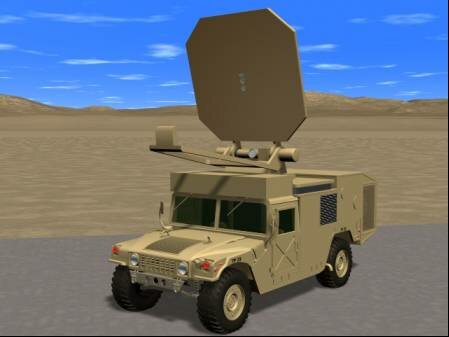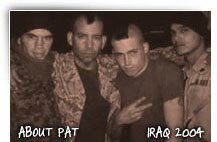Leftist-Created Abu Ghraib Hysteria Fuels Giant Ray Gun Controversy

WASHINGTON (AP) - It’s a ray gun that neither kills nor maims, but the Pentagon has refused to deploy it out of concern that the weapon itself might be seen as a torture device.
Perched on a Humvee or a flatbed truck, the Active Denial System gives people hit by the invisible beam the sense that their skin is on fire. They move out of the way quickly and without injury.
Saddam Hussein had been gone just a few weeks, and U.S. forces in Fallujah, west of Baghdad, were already being called unwelcome invaders. One of the first big anti-American protests of the war escalated into shootouts that left 18 Iraqis dead and 78 wounded.
It would be a familiar scene in Iraq’s next few years: Crowds gather, insurgents mingle with civilians. Troops open fire, and innocents die.
All the while, according to internal military correspondence obtained by The Associated Press, U.S. commanders were telling Washington that many civilian casualties could be avoided by using a new non-lethal weapon developed over the past decade.
Military leaders repeatedly and urgently requested—and were denied—the device, which uses energy beams instead of bullets and lets soldiers break up unruly crowds without firing a shot.
On April 30, 2003, two days after the first Fallujah incident, Gene McCall, then the top scientist at Air Force Space Command in Colorado, typed out a two-sentence e-mail to Gen. Richard Myers, chairman of the Joint Chiefs of Staff.
“I am convinced that the tragedy at Fallujah would not have occurred if an Active Denial System had been there,” McCall told Myers, according to the e-mail obtained by AP. The system should become “an immediate priority,” McCall said.
Myers referred McCall’s message to his staff, according to the e-mail chain.
McCall, who retired from government in November 2003, remains convinced the system would have saved lives in Iraq.
“How this has been handled is kind of a national scandal,” McCall said by telephone from his home in Florida.
A few months after McCall’s message, in August 2003, Richard Natonski, a Marine Corps brigadier general who had just returned from Iraq, filed an “urgent” request with officials in Washington for the energy- beam device.
The device would minimize what Natonski described as the “CNN Effect”—the instantaneous relay of images depicting U.S. troops as aggressors.
A year later, Natonski, by then promoted to major general, again asked for the system, saying a compact and mobile version was “urgently needed,” particularly in urban settings.
Natonski, now a three-star general, is the Marine Corps’ deputy commandant for plans, policies and operations. He did not respond to an interview request.
In October 2004, the commander of the 2nd Marine Expeditionary Force “enthusiastically” endorsed Natonski’s request. Lt. Gen. James Amos said it was “critical” for Marines in Iraq to have the system.
Senior officers in Iraq have continued to make the case. One December 2006 request noted that as U.S. forces are drawn down, the non-lethal weapon “will provide excellent means for economy of force.”
The main reason the tool has been missing in action is public perception. With memories of the Abu Ghraib prison scandal still fresh, the Pentagon is reluctant to give troops a space-age device that could be misconstrued as a torture machine.
“We want to just make sure that all the conditions are right, so when it is able to be deployed the system performs as predicted—that there isn’t any negative fallout,” said Col. Kirk Hymes, head of the Defense Department’s Joint Non-Lethal Weapons Directorate.
Reviews by military lawyers concluded it is a lawful weapon under current rules governing the conflicts in Iraq and Afghanistan, according to a Nov. 15 document prepared by Marine Corps officials in western Iraq.
Private organizations remain concerned, however, because documentation that supports the testing and legal reviews is classified. There’s no way to independently verify the Pentagon’s claims, said Stephen Goose of Human Rights Watch in Washington.
“We think that any time you have an emerging technology that’s based on novel physical principles, that this deserves the highest level of scrutiny,” Goose said. “And we really haven’t had that.”
Another issue for the weapon is cost.
The Pentagon has spent $62 million developing and testing the system over the past decade, a scant amount compared to other high-profile, multibillion-dollar military programs.
Still, officials say the technology is too expensive, although they won’t say what it costs to build. They cite engineering challenges as another obstacle, although one U.S. defense contractor says it has a model ready for production.
For now, there’s no firm schedule for when the system might be made and delivered to troops.
Commanders in Iraq say the go-slow approach has had devastating consequences.
There’s no way to calculate how many civilian deaths could have been avoided had the energy beam been available in Iraq. The bulk of the civilian casualties are due to sectarian warfare.
According to AP statistics, more than 27,400 Iraqi civilians have been killed and more than 31,000 wounded in war-related violence just since the new government took office in April 2005.
The Active Denial System is a directed-energy device, although it is not a laser or a microwave. It uses a large, dish-shaped antenna and a long, V-shaped arm to send an invisible beam of waves to a target as far away as 500 yards.
With the unit mounted on the back of a vehicle, U.S. troops can operate a safe distance from rocks, Molotov cocktails and small-arms fire.
The beam penetrates the skin slightly, just enough to cause intense pain. The beam goes through clothing as well as windows, but can be blocked by thicker materials, such as metal or concrete.
The system was developed by the Air Force Research Laboratory in New Mexico. During more than 12 years of testing, only two injuries requiring medical attention have been reported; both were second- degree burns, according to the Joint Non-Lethal Weapons Directorate Web site.
Prototype units have been assembled by the military, the most promising being a larger model that sits on the back of a flatbed truck. This single unit, known as System 2, could be sent to Iraq as early as next year, according to Hymes of the Joint Non-Lethal Weapons Directorate.
Hymes’ office, which nurtures promising technologies that can be used by the military branches, plans to spend $9 million over the next two years on the effort.
Money for additional systems isn’t likely to be available until 2010, when an Air Force command in Massachusetts is expected to take control of the program, he said.
Recognizing the potential market, defense contractor Raytheon has invested its own money to build a version that the company calls “Silent Guardian.” Although Hymes said the Raytheon product “is not ready yet,” company representatives say it is.
Mike Booen, Raytheon’s vice president for directed energy programs, said the company has produced one system that’s immediately available.
“We have the capacity to build additional systems as needed,” he said.
Raytheon has not sold any Silent Guardians to U.S. or foreign customers, and Booen would not discuss the product’s price.
American commanders in Iraq already have asked to buy Raytheon’s device.
A Dec. 1, 2006, urgent request signed by Marine Corps Maj. Gen. Robert Neller sought eight Silent Guardians.
Neller, then the deputy commander of the 1st Marine Expeditionary Force in Iraq, called the lack of such a non-lethal weapon a “chronic deficiency” that “will continue to harm” efforts to resolve showdowns with as little firepower as possible.
Other requests from officers in Iraq asked for the system as part of a broader weapons package on wheels, one that could shoot bullets as well as the non-lethal beam.
Such a versatile system would let troops deal with “increasingly complex operational environments where combatants are routinely intermixed with noncombatants,” Army Brig. Gen. James Huggins said in an April 2005 memo to Pentagon officials.
Huggins, then chief of staff of the Multi-National Force in Iraq and now deputy commander of the 3rd Infantry Division, wanted 14 vehicles for missions ranging from raids to convoy escorts.
U.S. Central Command, which oversees military operations in Iraq from its base in Tampa, Fla., backed the request, saying it was “critical to build upon our success in the counterinsurgency battle,” according to its memo to the Pentagon.
The vehicles were not delivered, however. Robert Buhrkuhl, a senior Pentagon acquisition official, said during congressional testimony in January that combining the various fixtures on a single vehicle presented major technical challenges.
In an interview, Franz Gayl, who was Neller’s science adviser until the unit returned in February, blamed an entrenched, “risk-averse” military acquisition system for moving too slowly.
Gayl calls the system a “disruptive innovation”—an unconventional piece of equipment that breaks new ground and therefore is viewed skeptically by the offices that buy combat gear.
If the energy-beam weapon had been fielded when U.S. forces invaded Iraq, “many innocent Iraqi lives would have been spared,” Gayl said.



 Be respectful of others and their opinions. Inflammatory remarks and inane leftist drivel will be deleted. It ain’t about free speech, remember you’re in a private domain. My website, my prerogative.
Be respectful of others and their opinions. Inflammatory remarks and inane leftist drivel will be deleted. It ain’t about free speech, remember you’re in a private domain. My website, my prerogative. If you can't handle using your real email address, don't bother posting a comment.
If you can't handle using your real email address, don't bother posting a comment.
The Dhims and leftists love to play the victim. Using a device such as this denies the looney left the “victims” that they need to play their victim games with.
Saving lives is just too humane and unmilitary especially in a leftist culture that thinks that every soldier or Marine is another William Calley.
What do you expect with screwballs like lawyers and Human Rights Watch being involved or being allowed input into the decision making process?
August 29th, 2007 at 1:19 pmwell this is some bullshit..The police already use a ray gun, its sorta like a stun grenade, it overwhelms the senses just long enough to knock the person off balance..then you grab them..I have seen this on futureweapons
August 29th, 2007 at 2:44 pmoh PS. the police use one mounted to a gun, it takes away sight for a short period of time. Mostly by SWAT..either way its not torture, it saves lives..a small burning sensation on the skin is better than lead to the brain
August 29th, 2007 at 2:49 pmwhat part of the civilian deaths were at the hands of terrorists, fatmahdi army, alqueda, iran, syria and baathists??? are we going to give them this thing also??? i believe that the civilian deaths at the hands of our MARINES and soldiers is at an all time low for war zones.. and i don’t believe that alot of the civilians killed are actually “civilians”,,
August 29th, 2007 at 3:01 pmScrew the enemy … Can we use the fucker on Congress and the MSM?
August 29th, 2007 at 5:28 pmlol congress and the MSM ARE the enemy
August 29th, 2007 at 9:41 pmso murdering civilians is better than “seeming” to torture them without physically hurting them? I’m confused!!
August 29th, 2007 at 10:41 pmI say toss all the terrorists in a pit and turn it on.. Leave it on. Come back in a few days. Then send them back into their neighborhoods where they can put the fear of allah into other idiots that think its cool to mess with us.
August 29th, 2007 at 11:32 pmAww, you’re breaking my heart, use the dam thing.
August 30th, 2007 at 2:30 amDeployment is up to the REMFs. Who don’t want anyone to say bad things about them. Good luck with that.
August 30th, 2007 at 7:59 pm